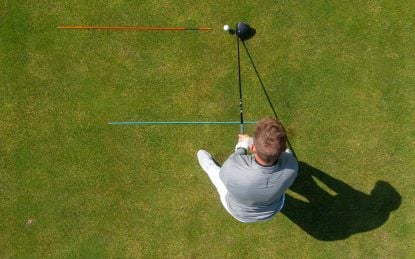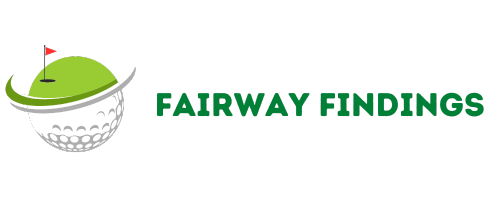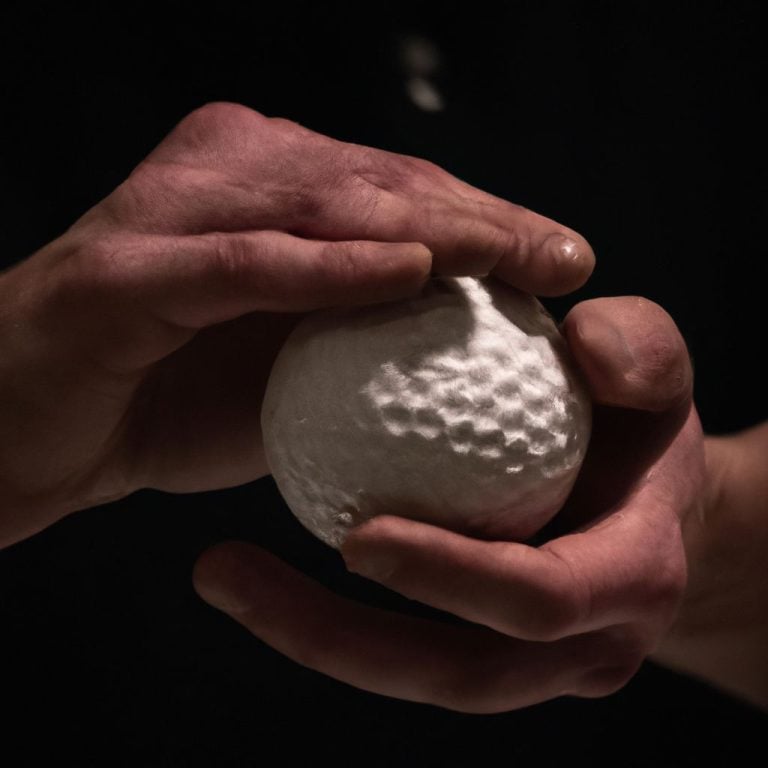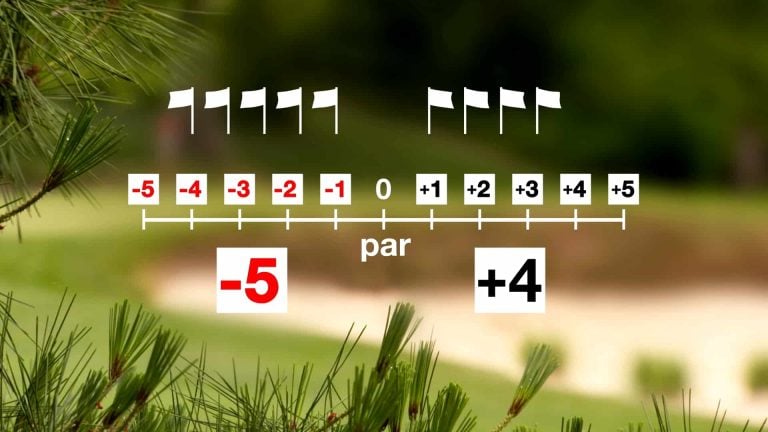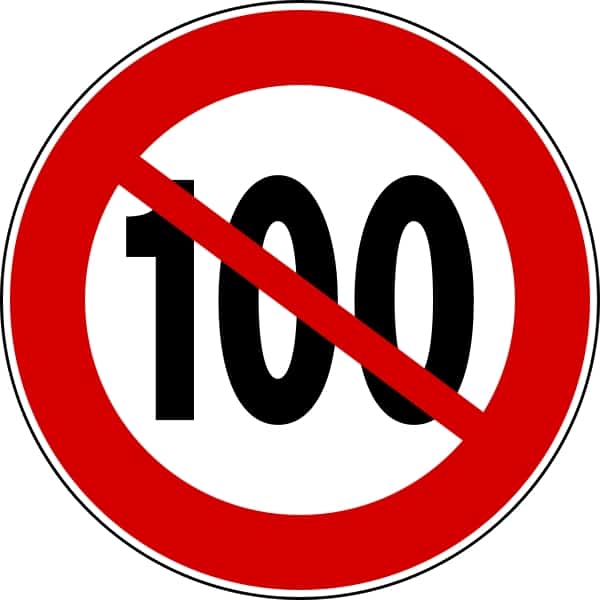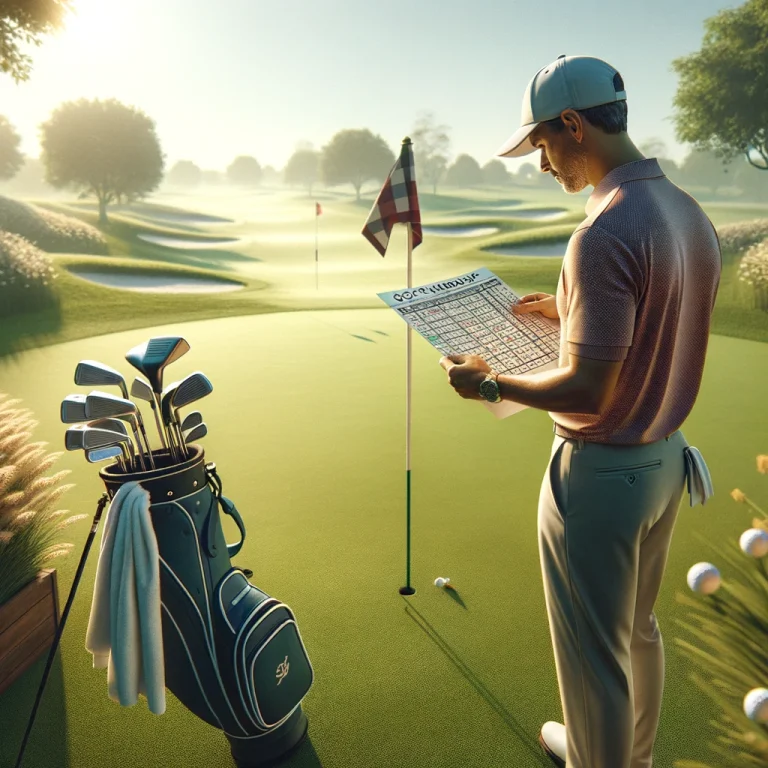Unlocking the Secrets: How to Aim in Golf and Hit Your Targets Every Time
Key Takeaways:
- Aiming and alignment are crucial in golf for achieving accuracy and consistency in ball flight.
- To aim the clubface, focus on aligning it with the target while aligning your body by positioning your feet, knees, hips, and shoulders parallel to the target line.
- Avoid common aim mistakes made by right-handed players to ensure proper alignment.
- Techniques for aiming include using the leading edge of the clubface as a reference point, using the lead shoulder as a visual cue, and utilizing an intermediate target for improved aim.
- Smart angles on tee boxes can also help with aiming and positioning for better shots.
- Expert golfers like Zane Scotland and Jack Nicklaus have recommended specific techniques for aim improvement, such as alignment calibration and correcting impact faults.
- An open and comfortable learning environment is important for effective aim improvement.
- Aiming tips for accuracy involve selecting a target, using intermediate targets, balancing time taken for aiming, aligning the clubhead before foot placement, and practicing with alignment sticks.
- Additional golf techniques and tips, such as Trillium Rose’s chipping technique and guidance on hitting a flop shot, can enhance your overall performance on the course.
- Considerations for landing near the edge of the green should also be taken into account for successful shots.
Importance of Aim and Alignment in Golf
In the world of golf, understanding the importance of aim and alignment is crucial for success. We’ll explore two key aspects in this section: aiming the clubface and aligning the body, as well as achieving consistent ball flight for proper aim. Additionally, we’ll uncover common aim mistakes made by right-handed players. Get ready to enhance your golfing skills and improve your accuracy on the fairway!
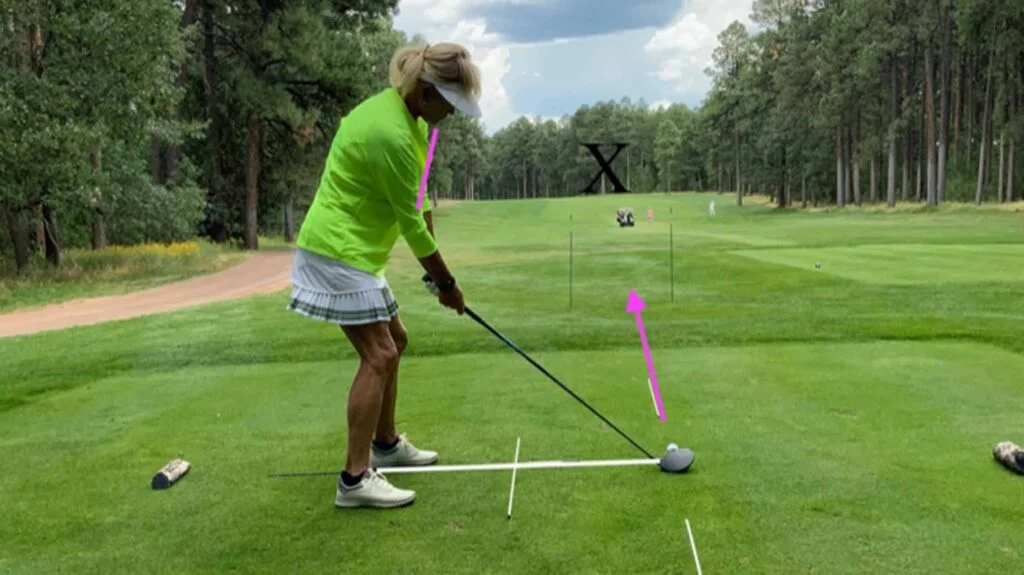
Aiming the Clubface and Aligning the Body
Clubface aim and body alignment are key for accuracy and consistency in golf. Clubface aim means setting it in the desired direction. Body alignment refers to proper positioning of feet, knees, hips, and shoulders to ensure a consistent swing. Together, these two elements set the base for successful shots.
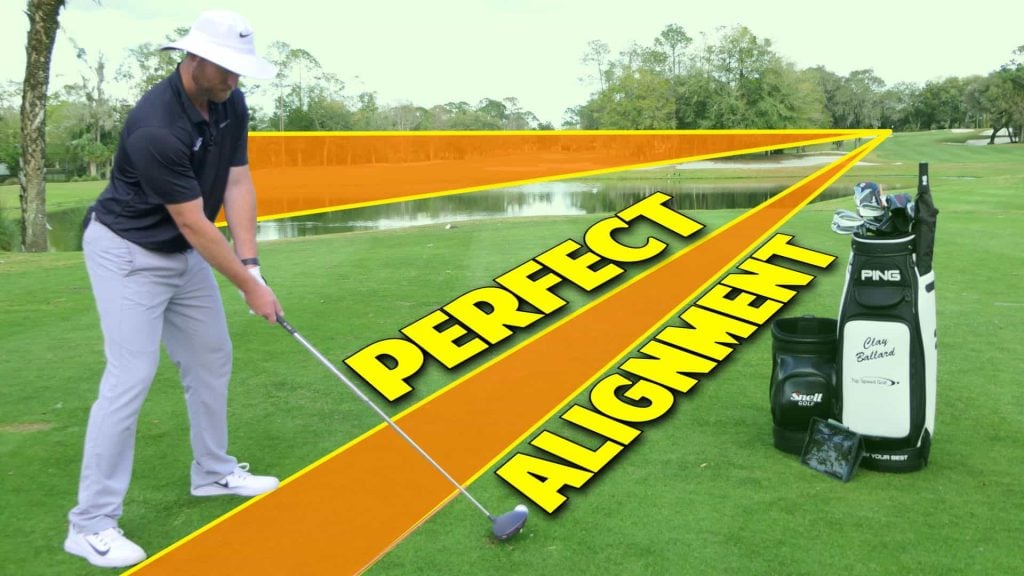
Leading edge is important for clubface aim – keep it parallel to the intended target line. Feet, knees, hips, and shoulders should also be parallel – shoulder width apart with toes perpendicular to the target line. Use the lead shoulder as a visual cue – slightly higher than the trailing shoulder at address.
Choose an intermediate target – a blade of grass or leaf on the ground – to help align both clubface and body towards the ultimate target. Utilize smart angles on the tee box to further refine your aim.
Each golfer may have unique variations, but following general guidelines can improve accuracy. Aim and alignment practice are key – build it into your pre-shot routine for better results. And remember, aim for consistent ball flight – it beats looking for golf balls in the rough!
Consistent Ball Flight for Proper Aim
Golfers have long known that consistent ball flight and proper aim are key to success on the course.

To help players achieve this, here’s a three-step guide:
- Clubface Alignment: Face the club towards the intended target. Make sure the leading edge is aligned with the target line. This ensures the face is square at impact, and the shot will be straighter and more accurate.
- Body Alignment: Line up the feet, knees, hips, and shoulders parallel to the target line. This promotes a natural swing path, allowing for better control of direction and trajectory.
- Visualization & Focus: Visualize the desired ball flight and stay focused during the swing. Use the lead shoulder as a visual cue and keep it pointed towards the intermediate target. Smart angles on tee boxes can aid in better alignment.
In addition to these techniques, practice sessions and alignment calibration can help players fine-tune their positioning. It is also important to understand common impact faults and how to correct them.
Common Aim Mistakes of Right-Handed Players
Right-handed golfers often make mistakes when aiming which can affect their accuracy and consistency on the course. These mistakes include:
- Misaligning the clubface
- Improper alignment of the body
- Aiming too far left
- Closing the clubface at impact
- Difficulty in hitting straight shots
It is important to address these mistakes and improve aiming skills. Taking lessons from experts or implementing techniques suggested by Jack Nicklaus can help. Additionally, creating a relaxed atmosphere can promote better aim technique.
An example of this is a right-handed golfer who was struggling with accuracy. Through analysis and practice, it was found that they had a tendency to misalign the clubface due to an improper grip. After making adjustments, their aim and overall shot accuracy improved significantly. This story shows how important it is to identify and address aim mistakes for right-handed players.
Aiming in golf is like trying to hit a bullseye with a blindfold and a banana for a club!
Techniques for Aiming in Golf
Enhance your golf game with effective aiming techniques. Learn how to align the clubface with the leading edge, position your body for optimal aim, and utilize visual cues for accuracy. Discover the benefits of using an intermediate target and smart angles on tee boxes to improve your aim and overall performance. Become a more precise golfer with these expert techniques.

Aiming the Clubface with the Leading Edge
Aiming the clubface with the leading edge is a must-know for golfers. It requires proper alignment to hit accurate shots. Knowing how to aim the leading edge can help golfers enhance their performance and reliability.
To get the right alignment for the leading edge:
- Make sure your body parts – feet, knees, hips, and shoulders – are aligned to your target line.
- Use the lead shoulder as a visual guide.
- Pick a spot between your ball and target to aim at, aiding accuracy.
- On tee boxes, employ strategic angles to generate the best results.
When aiming with the leading edge, selecting an appropriate intermediate target is crucial. Focusing on a spot between the ball and target helps with aim precision. Golfers can improve their aim accuracy and consistency by adding this practice to their game.
Expert golfer Zane Scotland recommends proper alignment for consistent shot making.
Aligning the Body: Feet, Knees, Hips, and Shoulders
For golf, body alignment is key. With the right feet, knees, hips, and shoulders, you can optimize your swing and hit your target. This setup helps you generate power and stay in control.
Position your Feet: Aim for parallel to the target line. Spread them shoulder-width apart, toes pointing out. This offers a stable base and keeps your balance.
Knees: Flex them slightly. Keep the target-side knee (left knee for righties) tilted inward. This balances your weight during the swing.
Hips: Keep them square or slightly open to the target. This helps you rotate while staying steady.
Shoulders: Line up with the feet and target line. This ensures the clubface takes the right path.
Balance: Weight should be even between both feet. Avoid swaying or losing balance.
Follow these body alignment steps, and you’ll hit your shots more consistently and accurately. Everyone’s body alignment is different, though, so use cues and drills to get it right. Alignment sticks and club shafts can help. Get feedback from a golf instructor, too.
Ace your game by mastering body alignment!
Using the Lead Shoulder as a Visual Cue
The lead shoulder is a key visual cue in golf. It helps players to line up their bodies and maintain a consistent swing. By using it as a reference, golfers can ensure their clubface and body are in line with the target. This technique boosts aim and improves accuracy.

To utilize the lead shoulder effectively:
- Stand with feet parallel to the target.
- Make sure hips, knees and shoulders are in line.
- Place more weight on back foot.
- Lift lead shoulder higher.
- Keep eyes on ball and target.
- Practice regularly.
Using the lead shoulder helps golfers improve aim and alignment. Zane Scotland and Jack Nicklaus have shared their own techniques too. Impact faults also need to be corrected for better aim. A comfortable environment is important for learning and refining aim. Pro golfers use intermediate targets to boost accuracy and lower scores.
Using an Intermediate Target for Improved Aim
Using an intermediate target in golf can vastly improve aim. Focus on a small spot or object on the ground and your alignment will be better. Here are three techniques to do this:
- Align the leading edge of the clubface with the target. This helps the clubface be in the right position at address and throughout the swing.
- Keep parts of the body parallel with the target. This includes feet, knees, hips, and shoulders to maintain alignment during the swing.
- Use an intermediate target strategically on tee boxes. Choose a spot or object to align with in order to get the best approach angle.
It’s important to envision a clear path from the ball to both the intermediate target and the final target. Visualize this during pre-shot routines and practice for a more consistent aiming process.
Using an intermediate target will help you get accurate shots and reach your desired outcome. Incorporate these techniques into practice and on-course play for greater confidence and success. Don’t miss out on this invaluable strategy for aiming in golf!
Getting the right angle on tee boxes is like finding the perfect selfie angle – it may take some tries, but when you get it, you’ll be feeling great!
Utilizing Smart Angles on Tee Boxes
Golfers must use smart angles on tee boxes to reach their goals. Align the clubface with your target and position your body correctly. Use your lead shoulder as a guide. To hone these skills, scout out the course ahead of time, practice visualization, and seek professional guidance. Consistent practice and patience are essential for mastering this skill and improving accuracy on the course.
Aiming for the perfect swing is like chasing a unicorn – it’s hard to find!
Tips from Golf Experts on Aiming
Looking for expert tips on improving your aim in golf? Get ready to take your game to the next level with valuable insights from golf professionals. From Zane Scotland’s aim improvement recommendations to Jack Nicklaus’ alignment calibration technique, this section will provide you with the tools you need to enhance your aiming skills.
Discover the impact faults and corrections for better aim, while also recognizing the importance of openness and comfort in your learning environment. Get ready to hit those targets with precision!
Zane Scotland’s Recommendations for Aim Improvement
Zane Scotland, a golf guru, has great tips to nail your aim. He emphasizes the importance of pointing the clubface and aligning the body. This will make sure you get a consistent ball flight. Zane also sheds light on typical right-handed player’s aim errors.
To ace aiming in golf, there are lots of methods. One is to aim the leading edge of the clubface. Also, line up your feet, knees, hips, and shoulders with the target. Use your lead shoulder as a visual clue to stay in line. Plus, setting an intermediate target increases accuracy. And, smart angles can be used on tee boxes to get ultimate aim.
For even more accuracy, look to Jack Nicklaus’ alignment calibration technique. Correcting impact glitches is also key. And, learn better in an open, comfortable environment.
A few more pointers can help you hit the mark in golf. Pick a target and approach each shot with intention. Professional golfers use intermediate targets as reference points. Balance the amount of time you take aiming. Align the clubhead before your feet. And practice with alignment sticks.
Trillium Rose has excellent advice for chipping techniques, and how to hit a flop shot near greens’ edges.
For better aim in golf, Zane Scotland is your guy. Use his tips and techniques to improve your accuracy and performance on the course. Don’t miss out on the chance to raise your game with these expert insights! And, as Jack Nicklaus would say, aim in golf is like calibrating a compass, finding the right alignment to ace the fairways and greens.
Jack Nicklaus’ Alignment Calibration Technique
The renowned professional golfer, Jack Nicklaus, developed the Alignment Calibration Technique. This technique focuses on improving alignment in golf and aiming correctly towards the target.
Nicklaus stresses aligning the body correctly. He suggests parallel positioning of the feet, knees, hips, and shoulders to the target line. This will give more accuracy and consistency in shots.
Nicklaus’ technique includes using an intermediate target for improved aim. This means choosing a spot or object between the ball and the actual target. This serves as a reference point and helps with aiming better.
Also, Nicklaus recommends using visual cues from the lead shoulder. Players should keep the lead shoulder parallel to the target line during setup. This creates a clearer visual reference for aiming.
Jack Nicklaus’ Alignment Calibration Technique offers valuable tips on improving alignment in golf. His guidance on body alignment, intermediate targets, and visual cues helps golfers make more accurate and consistent shots.
Impact Faults and Corrections for Better Aim
Aiming properly is essential in golf, as it directly affects shots’ accuracy and consistency. To fix impact faults and enhance aim, a few elements must be addressed.
An open clubface at impact is one of the most frequent issues. It causes right-handed players’ shots to veer off to the right. Aligning body parts such as feet, knees, hips, and shoulders parallel to the target line, plus using the lead shoulder as a visual cue, can help keep the clubface square at impact.
Inaccurate ball flight indicates an aiming problem. To solve this, golfers must understand and adjust factors like swing path and clubface angle, to aim consistently. Pros offer helpful advice to help with this. Zane Scotland advises maintaining an open stance at address to get a square clubface at impact. Jack Nicklaus suggests aligning the body to the target line and taking practice swings at other targets.
Golfers should also select a target before hitting the ball. This assists with concentration and alignment. Using intermediate targets as reference points during setup and the swing helps too.
Alignment sticks are also useful for enhancing aim. Placing them parallel to the target line during practice sessions helps create a better sense of alignment and trains the body to aim in the desired direction.
By following these tips and techniques, golfers can improve their aim for better accuracy on the course. Aiming the clubface correctly, understanding impact faults, and making corrections are all necessary for consistent and accurate shots in golf.
Importance of Openness and Comfort in the Learning Environment
Golfers need a supportive learning atmosphere to successfully improve their skills. Zane Scotland, an expert on the game, understands that openness and comfort are essential.
Players must be able to ask questions and voice doubts. Jack Nicklaus, a renowned golfer, believes this will help them better understand. Instructors can then address individual challenges, leading to improved aim alignment.
Comfort is also important. Trillium Rose, a professional golf coach, says it facilitates freedom of movement and decreases tension. This relaxed state helps with aim alignment and making smooth, successful movements.
Golfers need to make the most of the open and comfortable atmosphere. They should actively participate, as missing out on valuable techniques could greatly improve aim alignment.
Golf Aiming Tips for Accuracy
To achieve accuracy in golf, mastering the art of aiming is crucial. In this section, we will uncover the secrets behind effective golf aiming tips. From the significance of selecting the right target to the use of alignment sticks for practice, we’ll explore the techniques utilized by professional golfers. So, gear up and get ready to improve your aim on the green!
Importance of Aiming and Selecting a Target
Aiming and selecting a target in golf is very important. Aligning the clubface and body is key for accuracy and consistency. Aim the clubface with the leading edge and align your feet, knees, hips, and shoulders parallel to the target line.
Professional golfers use intermediate targets as visual cues to improve aim. Use smart angles on tee boxes to adjust aim. When aiming, select a target that aligns with the desired shot shape or intended landing area.
Practicing with alignment sticks helps develop muscle memory for alignment and aim.
Professional Golfer’s Use of Intermediate Targets
Golfers of a professional standard know the worth of using intermediate targets to advance their accuracy and aim on the golf course. These targets are visual references that help guide shots towards particular places on the fairway or green. By focusing on an intermediate target, golfers can line up their clubface and body in a better way, leading to more consistent shots.
Golf professionals such as Zane Scotland and Jack Nicklaus suggest this technique of intermediate targets. Scotland encourages smaller targets within the larger target area to boost focus and precision. On the other hand, Nicklaus emphasizes the significance of aligning with a certain spot on the fairway or green before swinging. Both strategies involve pinpointing an intermediate target to enhance aim.
In addition to alignment benefits, using intermediate targets also helps golfers manage distances more accurately. By picking an intermediate target that goes with a desired distance or landing area, players can have better control of their shots and raise their chances of hitting accurate approach shots or tee shots.
To make the most of intermediate targets, golfers must practice incorporating them into their pre-shot routines. This involves visually recognizing the target and concentrating on it while setting up the shot. By consistently using intermediate targets during practice sessions, golfers can create muscle memory and better their ability to aim accurately during actual rounds.
By implementing these techniques and using intermediate targets in their game, professional golfers acquire more accuracy and precision in their shots. They see the importance of having a specific point in mind when aiming, giving them the confidence to execute their swings and increase their chances of success on the course.
Incorporating intermediate targets into your own game can greatly affect your overall performance too. By practicing this technique and using it during your rounds, you can enhance your aiming abilities and get more consistent results on the course. So why not give it a go? Start incorporating intermediate targets into your pre-shot routine and feel the benefits for yourself. Don’t miss the chance to improve your accuracy and take your golf game to the next level.
Balancing Time Taken for Aiming
- Assess the target. Choose a spot to aim at. This gives a clear reference point and reduces doubt during setup.
- Make a pre-shot routine. This should include body alignment, setting up clubface, and imagining the ball flight path.
- Use alignment sticks. Put them on the ground, parallel to the target line. This helps you stay aligned and develop a sense of direction.
- Adapt to course conditions. Wind, terrain, or hazards may need extra attention. Adjust your aim for success.
Striking the right balance between aiming and speed helps improve golf performance and pace of play. Start by aligning your clubhead before thinking about where to put your feet.
Clubhead Alignment before Foot Placement
For proper clubhead alignment before foot placement, follow these 3 steps:
- Align the clubface: Make sure the leading edge of the clubface is parallel to your target line. This helps ensure the ball travels in the desired direction.
- Position your body: Once the clubface is aligned, position your feet, knees, hips, and shoulders parallel to the target line. This creates a clear swing path in the intended direction.
- Consistency: It’s important to maintain consistent clubhead alignment throughout the round. Monitor any changes in alignment and adjust accordingly.
Aligning the clubhead and foot placement gives you a stable foundation for a successful golf shot. It allows you to use the right body positioning and promote accurate ball striking.
Plus, there are other considerations for aiming in golf. For example, selecting an intermediate target for improved aim. Focus on a point between you and your ultimate target, such as a spot on the fairway or a tree. You can also use angles on tee boxes to optimize distance and accuracy.
By combining clubhead alignment and these additional techniques, you can aim better and improve your scores with ease.
Benefits of Practicing with Alignment Sticks
Alignment sticks are an invaluable asset for golfers striving to better their aptitude and sharpen their aim. Through the use of alignment sticks during practice sessions, golfers can gain in some ways:
- Accuracy Uplifted: Alignment sticks help golfers cultivate proper alignment and posture. By putting the sticks on the ground in a line with the goal, golfers can visibly assess their alignment and make changes as necessary. This creates more precise shots and a heightened performance on the course.
- Consistent Swing: Practicing with alignment sticks supports golfers to set up a steady swing. The sticks provide a visual instruction for keeping the correct clubhead positioning during the swing, resulting in more control over ball flight and distance.
- Ball Striking Improvement: Employing alignment sticks during practice helps golfers zero in on hitting the ball with the center of the clubface. By aligning the stick with the leading edge of the clubface, golfers can guarantee they are making strong contact every time. This contributes to superior shot quality and extended reach.
In addition to these advantages, employing alignment sticks in practice also allows golfers to form muscle memory and refine their technique. The persistent use of these tools helps to sink in right alignment and posture into muscle memory, making it easier for golfers to reproduce correct form on the course without being totally reliant on visual cues.
In conclusion, incorporating alignment sticks into practice habits can substantially increase a golfer’s aim and total performance on the course. Whether it be enhancing accuracy, improving consistency in swing, or strengthening ball striking capability, these adaptable tools provide numerous advantages that can contribute to success on the links.
Additional Golf Techniques and Tips
Discover essential techniques and tips to enhance your golf game in our section on Additional Golf Techniques and Tips. From Trillium Rose’s expert chipping technique to a comprehensive guide on how to execute a successful flop shot, we’ve got you covered. We’ll also explore key considerations when aiming to land near the edge of the green. Elevate your golf skills with these invaluable insights.
Trillium Rose’s Chipping Technique
Trillium Rose is a renowned golf expert. She developed a chipping technique that can significantly improve your game. It focuses on the precise angle and position of the clubface. With this technique, you can approach your shots with precision and accuracy.
Rose stresses the importance of proper setup and alignment. This includes the feet, knees, hips, and shoulders. Aligning the body correctly increases the chances of striking the ball cleanly. Lead shoulder is a useful visual cue to maintain proper alignment throughout the swing.
To enhance aim during chipping shots, Rose suggests focusing on an intermediate target. This helps better align the clubface with the desired landing area. Additionally, smart angles on tee boxes provide clearer lines of sight towards targets, giving an advantage.
Rose emphasizes openness and comfort in the learning environment. This encourages experimentation and helps enhance overall game. She offers valuable insights into other aspects of the game. This shows her dedication to helping golfers improve their skills in various areas.
In conclusion, Trillium Rose’s chipping technique is an effective way to improve your game. It offers precise angle and position, proper setup and alignment, and the use of intermediate targets. This technique enables players to confidently approach their shots with precision and consistency.
Guide on How to Hit a Flop Shot
- Pick a club with a high loft, like a lob wedge or sand wedge.
- Set up with an open stance, feet to the left of the target (for right-handed players). Open the clubface towards the target.
- Put the ball closer to the front foot in your stance.
- Take a shallow swing and brush the ground after impact. Use wrists for extra height and spin on the ball.
- Let your clubhead release fully and swing past your body. This will help you gain loft and control.
With practice, you can hit successful flop shots. But remember, sometimes wind, the ball’s lie, and the target’s distance can affect the situation. So assess these factors before attempting a flop shot.
Considerations for Landing Near the Edge of the Green
Landing close to the edge of the golf green requires careful thought. There are techniques and strategies that can help you get optimal results.
- Check Out the Lie: Consider the ball’s lie, like the length of the rough, the slope, and any nearby obstacles.
- Choose Your Club: Select a club based on the distance and any obstacles. Could be a pitching wedge, sand wedge, or even higher-lofted club.
- Pick a Landing Zone: Choose a spot on the green to land. This will give you a target and guide your shot.
- Control the Ball Flight: Adjust your swing to manage the flight and spin of the ball.
- Think About Green Conditions: Take into account the firmness, speed, and slope of the green when aiming for the edge.
- Visualize Success: See yourself successfully landing near the edge of the green to boost focus and confidence.
Be aware of any details particular to landing near the edge. Knowing these nuances can improve your technique and increase your chances of success.
Some Facts About How To Aim In Golf:
- ✅ Aiming the clubface and aligning the body are important for improving aim in golf. (Source: Team Research)
- ✅ Having a consistent ball flight helps with aiming properly. (Source: Team Research)
- ✅ Most right-handed players tend to aim too far to the right. (Source: Team Research)
- ✅ Aiming the clubface should be done with the leading edge of the club. (Source: Team Research)
- ✅ Aligning the body involves making sure the feet, knees, hips, and shoulders are parallel to the target line. (Source: Team Research)
FAQs about How To Aim In Golf
How should I align my body and clubface for better aim in golf?
To improve your aim in golf, it is important to align both your body and clubface properly. Align your feet, knees, hips, and shoulders parallel to the target line. Aim the clubface using the leading edge of the club. This will ensure proper alignment and improve your aim.
What are some common aiming mistakes in golf?
Some common aiming mistakes in golf include aiming too far to the right for right-handed players, not checking alignment before shots, and failing to use spot alignment. It is important to be aware of these mistakes and work on correcting them to improve aim.
How can I improve my aim when hitting green-side pitch shots?
When hitting green-side pitch shots, it is important to select a target to aim at. Use spot alignment by picking a spot a foot or two in front of the ball on the target line to help align correctly. Taking time to aim and practicing with alignment sticks can also improve your aim when hitting green-side pitch shots.
What should I include in my pre-shot routine to improve my aim in golf?
To improve your aim in golf, a helpful pre-shot routine can be beneficial. Take your time to aim the club head before placing your feet. Use an intermediate target a few feet in front of the ball to aim accurately. Looking back and forth between the ball and the target during setup can also help improve your aim.
What role does the club face position play in aiming properly?
The club face position is crucial for aiming properly in golf. Aiming the clubface using the leading edge of the club helps ensure proper alignment. Knowing how to adjust the club face based on your predominant ball flight can also help you aim accurately and improve your overall performance.
Is aiming in golf an earned skill or a natural ability?
Aiming in golf is an earned skill that requires practice and a positive attitude. It is not solely dependent on natural ability. With consistent practice and dedication, golfers can improve their aim and achieve more accurate shots on the course.
